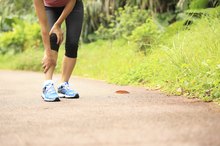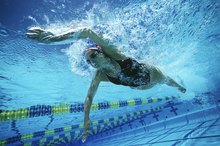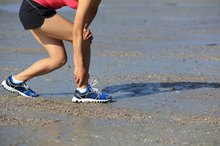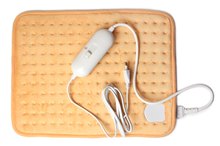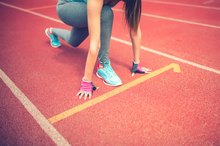Cycling and Calf Pain
Cycling is not only an eco-friendly mode of transportation but also a great way to lose weight or maintain a healthy weight, improve blood flow and circulation and cut your risk for heart disease, stroke, diabetes and some cancers. Cycling is a low-impact activity and is easy on your joints, especially the knees. It's still possible, however, to suffer from muscle strains and cramps, especially in the calf muscles, while cycling.
The Calf
The gastrocnemii, or calf muscles, are located in the back of the legs, just below the knees. The quadriceps play a big role in producing the power that turns a bicycle's cranks, but the calf muscles are involved as well. During hard efforts, cycling stresses the muscles, tendons and bones of the leg, therefore resulting in muscle tears and pain. Muscular imbalances can place additional stress on the calves, making them tight and more vulnerable to injury.
- The gastrocnemii, or calf muscles, are located in the back of the legs, just below the knees.
- The quadriceps play a big role in producing the power that turns a bicycle's cranks, but the calf muscles are involved as well.
Muscle Strains
What to Do for a Sore Calf From Hiking
Learn More
Any time you overexert a muscle, the muscle fiber is more prone to suffering from tiny tears. Calf strain can also be caused by overstretching or heavy work to the muscle before it's warmed up. Depending on the extent of the damaged tissue, muscle strains can cause pain for days or weeks. Symptoms include pain, tenderness and stiffness in the calf. If you suffer from a strain, treat it with rest, avoid cycling until the pain is gone and apply ice up to four times a day, and compress and elevate the leg.
- Any time you overexert a muscle, the muscle fiber is more prone to suffering from tiny tears.
- If you suffer from a strain, treat it with rest, avoid cycling until the pain is gone and apply ice up to four times a day, and compress and elevate the leg.
Muscle Cramps
Muscle cramps produce a sudden pain that can be either mild or agonizing. They can occur anywhere from a few seconds to 20 minutes or longer. While the cause is still unknown, muscle cramps are more common in athletes who suddenly ramp up their routine, exercise in extreme heat or who are depleted of electrolytes or are dehydrated. When you experience a cramp, gently stretch and massage the calf and stop cycling until it goes away. To prevent cramps, slowly build up the intensity of your exercise routine, stretch, properly hydrate and make sure you have consumed enough sodium and calories, especially from carbohydrates.
- Muscle cramps produce a sudden pain that can be either mild or agonizing.
- While the cause is still unknown, muscle cramps are more common in athletes who suddenly ramp up their routine, exercise in extreme heat or who are depleted of electrolytes or are dehydrated.
Other Considerations
How to Run With a Pulled Hamstring
Learn More
There are other conditions that cause calf pain. Tennis leg occurs when there is a tear in the medial of the calf, which is felt as a sharp and sudden pain during the power phase of your pedal stroke. It's important to allow the tear to heal before you begin cycling again. Peripheral artery disease can be caused by an arterial blockage in the leg that subsides after cycling but causes pain in the calf while pedaling. You can also experience bruising, changes in skin color and numbness. If you experience these symptoms, call your physician right away.
- There are other conditions that cause calf pain.
- Peripheral artery disease can be caused by an arterial blockage in the leg that subsides after cycling but causes pain in the calf while pedaling.
Related Articles
References
- University of Rochester Medical Center: Peripheral Vascular Disease
- NYU Pediatrics: Calf Muscle Strain; Laurie LaRusso
- Rainbow CR, Fields KB. Calf injuries not involving the Achilles tendon. Fricker P, ed. UpToDate. Updated Feb 7, 2019.
- Chikazawa K, Netsu S, Akashi K, Suzuki Y, Konno R, Motomatsu S. Delayed diagnosis of single compartment muscle contusion after radical hysterectomy in the lithotomy position: A case report. Int J Surg Case Rep. 2016;26:199-201. doi:10.1016/j.ijscr.2016.07.057
- Fields KB, Rigby MD. Muscular Calf Injuries in Runners. Curr Sports Med Rep. 2016;15(5):320-4. doi:10.1249/JSR.0000000000000292
- Freedman BR, Gordon JA, Soslowsky LJ. The Achilles tendon: fundamental properties and mechanisms governing healing. Muscles Ligaments Tendons J. 2014;4(2):245-55.
- Alessandrino F, Balconi G. Complications of muscle injuries. J Ultrasound. 2013;16(4):215-22. doi:10.1007/s40477-013-0010-4
- Picerno V, Filippou G, Bertoldi I, et al. Prevalence of Baker's cyst in patients with knee pain: an ultrasonographic study. Reumatismo. 2014;65(6):264-70. doi:10.4081/reumatismo.2013.715
- Baima J, Krivickas L. Evaluation and treatment of peroneal neuropathy. Curr Rev Musculoskelet Med. 2008;1(2):147-53. doi:10.1007/s12178-008-9023-6
- Petsche TS, Selesnick FH. Popliteus tendinitis: tips for diagnosis and management. Phys Sportsmed. 2002;30(8):27-31.doi:10.3810/psm.2002.08.401
- Stager A, Clement D. Popliteal artery entrapment syndrome. Sports Med. 1999;28(1):61-70. doi:+10.2165/00007256-199928010-00006
- Mcdermott MM. Lower extremity manifestations of peripheral artery disease: the pathophysiologic and functional implications of leg ischemia. Circ Res. 2015;116(9):1540-50. doi:10.1161/CIRCRESAHA.114.303517
- Crum-cianflone NF. Bacterial, fungal, parasitic, and viral myositis. Clin Microbiol Rev. 2008;21(3):473-94. doi:10.1128/CMR.00001-08
- Somford MP, Hoornenborg D, Wiegerinck JI, Nieuwe weme RA. Are You Positive That the Simmonds-Thompson Test Is Negative? A Historical and Biographical Review. J Foot Ankle Surg. 2016;55(3):682-3. doi:10.1053/j.jfas.2016.01.021
- Pulivarthi S, Gurram MK. Effectiveness of d-dimer as a screening test for venous thromboembolism: an update. N Am J Med Sci. 2014;6(10):491-9. doi:10.4103/1947-2714.143278
- Bryan dixon J. Gastrocnemius vs. soleus strain: how to differentiate and deal with calf muscle injuries. Curr Rev Musculoskelet Med. 2009;2(2):74-7. doi:10.1007/s12178-009-9045-8
- Mackman N. Triggers, targets and treatments for thrombosis. Nature. 2008;451(7181):914-8. doi:10.1038/nature06797
- Muir RL. Peripheral arterial disease: Pathophysiology, risk factors, diagnosis, treatment, and prevention. J Vasc Nurs. 2009;27(2):26-30. doi:10.1016/j.jvn.2009.03.001
- American Academy of Orthopedic Surgeons. Muscle Contusion (Bruise). Updated 2014.
- American Physical Therapy Association. Physical Therapist's Guide to Calf Strain. Updated Oct. 17, 2019.
- Childress MA, Beutler A. Management of Chronic Tendon Injuries. Am Fam Physician. 2013 Apr 1;87(7):486-90.
- Grabowski G, Whiteside WK, Kanwisher M. Venous Thrombosis in Athletes. J Am Acad Orthop Surg. 2013 Feb;21(2):108-17.
- Rainbow CR, Fields KB. Calf injuries not involving the Achilles tendon. Fricker P, ed. Updated Feb 7, 2019.
Writer Bio
A professional writer since 2004, Abby Roberts holds a Bachelor of Arts in writing and has worked as a magazine editor, a staff writer and as a freelance writer for "Muscle and Fitness Hers" magazine. Roberts also produces a blog for female cyclists. She has experience working with cyclists in different facets of training and performance enhancement.
